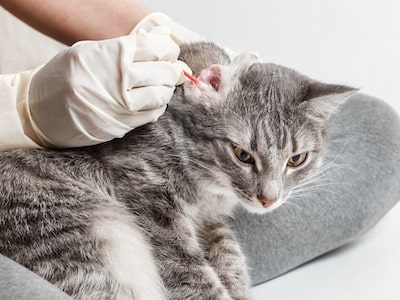As cat owners, we constantly strive to ensure the well-being and safety of our beloved companions. In our pursuit of natural remedies, one question often arises: is witch hazel safe for cats?
With its long history of medicinal use and a wide range of benefits for humans, it’s natural to wonder if this plant-derived extract holds the same potential for our furry friends.
In this article, we will explore the topic in depth, providing insights from veterinary experts and shedding light on the potential risks and benefits of using witch hazel on cats.
So, join us as we embark on this investigative journey to uncover the truth about witch hazel and its safety for our feline companions.
What is Witch Hazel?
Witch hazel is a plant that belongs to the Hamamelidaceae family. It is native to North America and Asia and has yellow flowers that bloom in the fall or winter. The scientific name of witch hazel is Hamamelis virginiana, which is also the name of its active ingredient.
Hamamelis virginiana is a type of tannin that has anti-inflammatory, astringent, and antioxidant properties. It can help reduce swelling, bleeding, and bruising in humans.
It can also help heal wounds, infections, and burns. It can also soothe itching, irritation, and inflammation caused by various skin conditions, such as eczema, psoriasis, acne, or sunburn.
Witch hazel can be extracted from the leaves, bark, and twigs of the plant. It can be used as a tea, a tincture, a cream, or a wipe. It can also be added to other products, such as toners, moisturizers, or shampoos.

Why Do People Use Witch Hazel For Cats?
One of the most common reasons why people use witch hazel for cats is to relieve itching. Itching is the most common symptom of allergies in cats and can lead to allergic dermatitis. Allergic dermatitis is a type of skin irritation that develops after a cat is exposed to an allergen to which they are allergic.
Allergens can be anything from pollen, dust mites, mold, or food to flea bites, medications, or chemicals. When a cat comes in contact with an allergen, their immune system overreacts and produces histamine. Histamine causes inflammation and itching in the skin.
Some people may think that applying witch hazel to their cat’s skin can help reduce the inflammation and itching caused by allergies. They may also think that witch hazel can help treat other skin problems in cats, such as acne, fleas, ear infections, or eye infections.
However, this is not true. Witch hazel is not safe for cats and can cause more harm than good.
Benefits and Risks of Witch Hazel for Cats
Witch hazel can offer several potential benefits for cats when used appropriately. Here are some of the potential benefits of witch hazel for cats:
- Skin Soothing: Witch hazel possesses natural astringent and anti-inflammatory properties, which can help soothe minor skin irritations in cats. It can also help reduce swelling, redness, and itching caused by allergies or infections.
- Wound Healing: Witch hazel can help promote wound healing by cleaning the wound site, preventing infection, and stimulating blood circulation. It can also help reduce bleeding and pain in minor wounds.
- Flea Repellent: Witch hazel can help repel fleas by creating an unpleasant environment for them on the cat’s skin and coat. It can also help relieve the itching and inflammation caused by flea bites.
However, witch hazel also poses some risks for cats when used improperly or excessively. Here are some of the potential risks of witch hazel for cats:
a) Toxicity: Witch hazel contains tannins and phenolic acids that can cause toxicity in cats if ingested or absorbed through the skin. These compounds can interfere with the liver function, cause gastrointestinal distress, damage red blood cells, and affect the nervous system.
Symptoms of witch hazel poisoning in cats include vomiting, diarrhea, drooling, lethargy, tremors, seizures, and coma. In severe cases, witch hazel poisoning can be fatal for cats.
b) Irritation: Witch hazel can also cause irritation and inflammation in cats’ skin and mucous membranes. Cats have very sensitive skin that can react negatively to witch hazel’s astringent and drying properties.
Witch hazel can also irritate cats’ eyes, nose, mouth, ears, and genitals if applied or sprayed on these areas. Irritation can lead to itching, scratching, licking, biting, chewing, and self-mutilation in cats.

c) Allergic Reaction: Some cats may be allergic to witch hazel or its ingredients. An allergic reaction can cause symptoms such as hives, rash, swelling, difficulty breathing, anaphylaxis, and death. An allergic reaction can occur even if the cat has been exposed to witch hazel before without any problem.
d) Interference: Witch hazel can interfere with some medications or treatments that your cat may be taking or receiving from your vet.
For example, witch hazel can reduce the effectiveness of some antibiotics or antifungals by creating a barrier on the skin that prevents them from penetrating into the infected area.
It can also interact with some blood thinners or anti-inflammatory drugs by increasing the risk of bleeding or bruising.
Symptoms of Witch Hazel Poisoning in Cats
If you suspect that your cat has been exposed to witch hazel or has ingested it accidentally, you should look out for the following symptoms:
- Vomiting
- Diarrhea
- Drooling
- Lethargy
- Tremors
- Seizures
- Coma
These symptoms may appear within minutes or hours after exposure or ingestion. They may vary depending on the amount and type of witch hazel involved.
How to Apply Witch Hazel to Your Cat Safely and Effectively
If you want to use witch hazel on your cat, you should follow these steps to ensure safety and effectiveness:
- Consult your vet: Before using any product on your cat, you should always consult your vet first. Your vet can advise you on whether witch hazel is suitable for your cat’s condition, how much and how often to apply it, and what precautions to take. Your vet can also monitor your cat’s response to witch hazel and adjust the treatment accordingly.
- Choose a cat-safe product: You should only use witch hazel that is specifically made for pets and avoid using any product that is not designed for felines. Some human products may contain alcohol or other additives that can be harmful to cats. You should also check the label for the concentration of witch hazel and choose a product that has a low percentage (usually 10% or less) of witch hazel extract.

- Test for sensitivity: Before applying witch hazel to your cat’s skin or fur, you should test for sensitivity by applying a small amount to a hidden area, such as the inside of the ear or the belly. Wait for 24 hours and observe for any signs of irritation, such as redness, swelling, or itching. If your cat shows any adverse reaction, stop using witch hazel and contact your vet.
- Apply gently and sparingly: When applying witch hazel to your cat’s skin or fur, you should use a clean cotton ball or pad and gently dab or wipe the affected area. Do not rub or scrub the skin or fur, as this can cause more irritation or damage. You should also avoid applying witch hazel to open wounds, eyes, ears, nose, mouth, or genitals, as this can cause pain or infection. You should only apply witch hazel once or twice a day and not more than that.
- Prevent licking: After applying witch hazel to your cat’s skin or fur, you should prevent your cat from licking it off by distracting them with a toy or a treat. You can also use a cone collar or a bandage to cover the treated area and prevent access. You should also wash your hands thoroughly after handling witch hazel to avoid transferring it to your cat’s mouth or eyes.
What Are Some Safe Alternatives to Witch Hazel For Cats?
If you want to help your cat with their itching, inflammation, and bruising, there are some safe alternatives to witch hazel that you can use. These include:
- Oatmeal baths: Oatmeal has soothing and anti-inflammatory properties that can help relieve itching and irritation in cats. You can make an oatmeal bath by grinding some plain oatmeal into a fine powder and adding it to warm water. You can then soak your cat in the oatmeal bath for about 10 minutes and rinse them off with clean water.
- Coconut oil: Coconut oil has moisturizing and antibacterial properties that can help heal wounds, infections, and burns in cats. You can apply a small amount of coconut oil to your cat’s skin or fur and massage it gently. You can also add some coconut oil to your cat’s food to boost their immune system and skin health.

- Aloe vera gel: Aloe vera gel has cooling and healing properties that can help soothe inflammation and pain in cats. You can apply some pure aloe vera gel to your cat’s skin or fur and let it dry naturally. You can also give your cat some aloe vera juice to drink to help with digestion and hydration.

- Chamomile tea: Chamomile tea has calming and anti-inflammatory properties that can help reduce swelling and bruising in cats. You can make some chamomile tea by steeping some dried chamomile flowers in hot water for about 10 minutes. You can then let the tea cool down and apply it to your cat’s skin or fur with a cotton ball or a spray bottle.
FAQs
Can witch hazel be used on cats for other purposes, such as cleaning or grooming?
While witch hazel may have some cleansing properties, it is not recommended to use it as a general-purpose cleaner or grooming product for cats. Cats have sensitive skin, and using unfamiliar substances on them may cause irritation or discomfort. Stick to cat-specific grooming products and consult with your veterinarian for proper cleaning recommendations.
Can witch hazel be toxic if ingested by cats?
While small amounts of witch hazel are generally considered safe for topical use on cats, ingestion of witch hazel can be harmful. It is important to keep witch hazel products out of reach of your cat, as ingestion may lead to digestive upset, vomiting, or other potential complications. If you suspect your cat has ingested witch hazel, contact your veterinarian immediately.
Can witch hazel be used to clean a cat’s ears?
No, it is not recommended to use witch hazel to clean a cat’s ears. Cleaning a cat’s ears requires specific veterinary-approved ear cleaners formulated for cats. The ear canal of a cat is delicate, and using witch hazel or any other unapproved substances can lead to irritation, injury, or even ear infections. Consult with your veterinarian for proper ear cleaning methods and products.
Can witch hazel be used on kittens?
The use of witch hazel on kittens should be approached with caution. Kittens have more sensitive skin than adult cats, and their bodies may not tolerate certain substances as well. It is best to consult with a veterinarian before using any products, including witch hazel, on kittens to ensure their safety and well-being.
Well, That’s a Wrap
In conclusion, the question of whether witch hazel is safe for cats requires careful consideration and veterinary guidance. While witch hazel can offer potential benefits for certain skin conditions in cats, it is crucial to prioritize their safety and well-being.
Consulting with a veterinarian before using any new products on your cat is essential to assess any potential risks, determine appropriate usage guidelines, and explore alternative treatments if necessary.
Remember that each cat is unique, and what may work well for one cat may not be suitable for another. Your veterinarian is the best source of information and advice when it comes to your cat’s health and specific needs.
When using witch hazel on cats, it is vital to choose alcohol-free and fragrance-free varieties, apply it topically with care, and avoid sensitive areas such as the eyes, ears, or any open wounds. Monitoring your cat for any signs of discomfort, irritation, or adverse reactions is essential, and discontinuing use if any issues arise.
